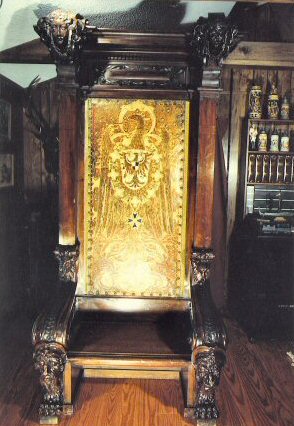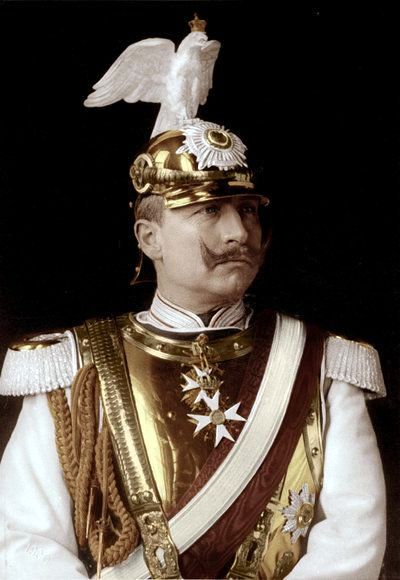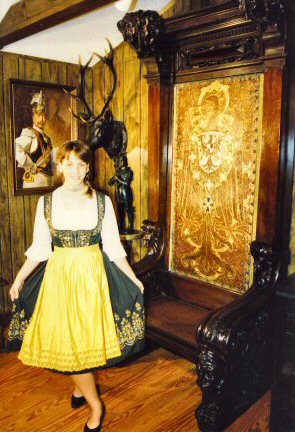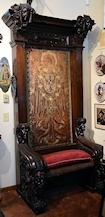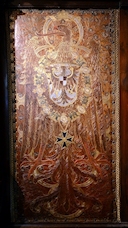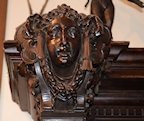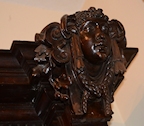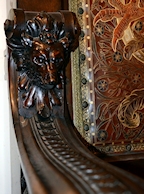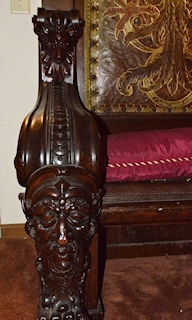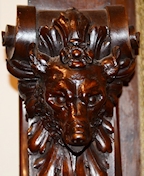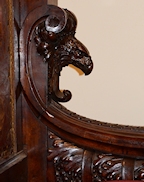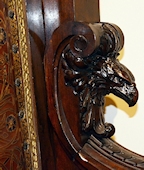|
|
|
|
Kaiserlichstuhl: The Reichstag Chair
Page 6
| |||||||||||||||||||||||||||||||||||||||
|
Kaiserlichstuhl: The Reichstag Chair (Item WILHELM 6-1; KHISTORY 1-7) |
|||||||||||||||||||||||||||||||||||||||
| DESCRIPTION: This is without a doubt the most fantastic Kaiserzeit item ever found and actually brought back from the wars. Collectors and historians have called it the Kaiserlichstuhl "Kaiser Chair," but the fact is he never sat in it because he was always the complete monarchist and he referred to Parliament (the Reichstag) as the Reichsaffenhaus or "Monkey House." This piece of grand furniture resembles much more a throne that a chair. It once sat in the Reichstag in the lobby or entrance room for the Bundesrat (Federal Council). It was put together by three of the most famous of the artists in decorative furnishings that Germany had ever seen. The original design was by the great art sculptor Professor Anton Pruska in Munich. The leather carving was painstakingly executed by George Hulbe of Hamburg. The carving and final finishing was by the man who is called the Frank Lloyd Wright of German furnishing, Anton Pössenbacher, of Munich's Odenplatz. We have a letter from the Deutscher Bundestag in Berlin dated June 25, 1991, where a Mr. E. Mattig, one of the curators of the historic research section, provides some information concerning the history of the chair. In 1985, he referred us to a gentleman named Michael S. Cullen, an American, who lived in Berlin and was contacted about the history of this monumental piece. Cullen had written a book called, Der Reichstag. Die Geschichte eines Monumentes, The Reichstag. The History of a Monument. Mr. Cullen also verified the authenticity and history of the chair and supplied actual pictures of the article as it looked sitting in the Reichstag building in the 1920's. The pictures revealed that there were four of these chairs and two benches that were basically of the same design. All except this one were reduced to ashes when the vicious Bolshevik hordes of Mongols and Tartars of the red army swarmed like rats all over Berlin in an "ape dance" of bestial rampage killing, raping, and murdering. Nothing of the old majestic Reichstag survived except for this single chair and that was because it had been sent to a repair shop long before the end of the war. Because of the impact of action even in 1943, work and deliveries to a great extent were curtailed, except for food and oil and other necessities. So, the chair fortunately sat in the shop and thereby missed the conflagration visited upon the once beautiful Reichstag building. After the war an American ranking officer of the occupation forces became aware of this article sitting in the show window of this repair shop. Since is was for the most part the reds that occupied the city, he, as a liaison officer, had to bribe the commies to not only look the other way, but to actually assist him in getting it packed up and loaded in an American truck to be sent to the American occupation zone in Munich. This having been accomplished after the expenditure of several cartons of Lucky Strikes this officer managed to make off with a treasure. After arrival in Munich the chair was dismantled and sent to Texas where it sat in a storage facility for many years until an American collector-dealer of some repute in Texas came to know about it and managed to acquire it, but payed a price equivalent to back-storage fees. Whatever happened to the officer who sent it to America we don't know (we weren't informed of his name or the liaison unit he was attached to). So now, a Kaiserstuhle of the Deutsches Reichstag sits in another warehouse in the states after being bought from the Texas entrepreneur (now deceased). The chair or, as we prefer to call it, throne, is awesome indeed. Its towering height is about 103 inches from floor to top and 47 inches across. It is nearly 9 feet tall and two average-sized people can easily sit side by side in the seat. The carving is nothing less than phenomenal with two Walkyries from Wagner's Der Ring des Nibelungen at the top. The faces of these, the daughters of Wotan and Erda, Brünnhilde and Waltraute, are both different. The arms of the throne are fronted with two more different faces. These are thought to be the giants, Fasolt and Fafner, also from the Wagnerian saga. At the middle of the structure are the heads of an eagle and a wolf executed in the finest of wood carving also. The wolf and the eagle represent terrestrials that appear halfway through Wagner's immortal ring cycle. They are magical creatures belonging to the Germanic sky god, Wotan. They are often portrayed as the mounts that he rides. The giant German eagle, all carved in leather, has the Hohenzollern eagle depicted in the center of the chest to honor Kaiser Wilhelm, himself, who never sat in this chair. The Kaiser often said that the Reichstag was a "house of monkeys!," Affenhaus. He was a total monarchist having no respect for the parliamentarian process. But, somehow, we feel had he ever seen these magnificent pieces of grandiose furniture his sense of artistic appreciation for which he was well known would have made him salute, at least. He was an exalting monarch, but everything that went straight from Germanic saga went into this carving and leatherwork. All of this was the stuff of his favorite legends and heraldic appreciation. Pössenbacher, the major contributor to these masterpieces was himself legendary in the 1800's and still today his work is seen as part of Germany's national treasures. He was the designer and builder of practically all of the magnificent furnishings for the Royal Bavarian palaces. The one that stands out foremost is King Ludwig's very famous tribute to the works of Richard Wagner, the castle, Neuswanstein, in lower Bavaria. But he also was the court cabinetmaker to Ludwig's father. The incredible fanciful furnishings were even entered into the official history books as "German Historicism" and they were immensely popular with monarchs, wealthy merchants, industrialists, and in general, the Teutonic aristocracy. His designs represented in that time German craftsmanship at its zenith! The royal apartments of Linderhof and Herrenchiemsee were done to King Ludwig's specifications. Back to Anton Pössenbacher; the fame of this man and his prestigious firm is legion. His firm was the designer and builder of practically all the magnificent carved luxury furnishings for Reichmarschal Herman Göring's Prussian lodge, Karinhalle. This master artist was also responsible for all the incredibly fanciful objects of wooden décor at Neuswanstein. See the book, Möbel für den Märchenkönig, Furniture for the Dream King), and the Munich court cabinetmaker, Anton Pössenbacher. Even today, when viewed, these masterpieces of the cabinetmaker's art have lost nothing of their original fascination. Not content with resting upon his laurels in Ludwig's Bavaria, Pössenbacher also designed for other rulers such as King Charles of Rumania for whom he designed an elegant palace library in Bucharest in 1887. After his death the firm that bore his name continued in the proud tradition of excellence in design. The exquisite furnishings in the fabulous Hermann Göring lodge known as Karinhalle were designed partially by the Reichsmarschal, himself, with the advice and final installation by the Pössenbacher firm. Anton would have been prodigiously proud of the masterful execution of this accomplishment in the east Prussian forest. But like the Reichstag furnishings, all of this is gone up in the flames of the savage, hellish onslaught of the bestial, unthinking Russian hordes as they destroyed every cultural object in their path. In the pictures provided by Mr. Cullen, you can see a pair of eagles at the very top of the chair with a floral bouquet. Unfortunately, this is missing and it probably was the part that was being repaired and refitted at the shop where it was found (thank goodness). So, although for now these parts are down the memory hole, we can only hope that someday fate will bring a future master carver to the fore and these pieces will be duplicated from the original pictures and the old throne may once more sit in the Reichstag building where it belongs. POR (price on request). We will only discuss this piece and its possible selling price on the telephone (706.782.1668). Please do not ask for further details or price by email. Serious inquiries by museums or established historic trusts are invited. Calls on this are accepted from 10:00 am to 11:45 am U.S. eastern time, or 9:30 pm to 11:30 pm U.S. eastern time. PRICE: POR |
| Page Six |
Please refer to item designator in parentheses in all correspondence.
Please E-mail for any additional information you may need.If you prefer, contact 'Germania' at PO Box 68, Lakemont, GA 30552
or call at 706.782.1668 or 706.782.4398.
Please! do not call during the wee hours of the morning. The best time for calling us is between 9 and 11 am and between 9 and 11 pm eastern time.


